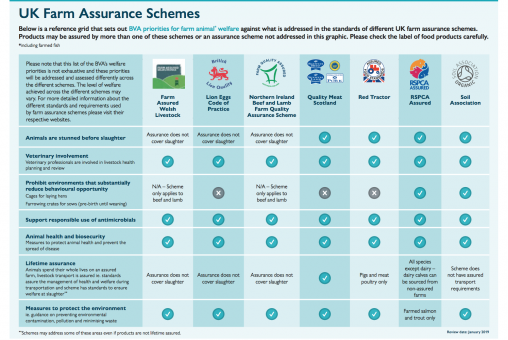The Pig Veterinary Society (PVS) has distanced itself from an infographic published by the British Veterinary Association (BVA), claiming it does a ‘disservice’ to the positive welfare aspects of schemes like Red Tractor.
 The infographic, which can be downloaded here, sets out the BVA’s priorities for farm animal welfare and indicates, in its view, whether or not the schemes address these priorities in their standards.
The infographic, which can be downloaded here, sets out the BVA’s priorities for farm animal welfare and indicates, in its view, whether or not the schemes address these priorities in their standards.
All seven schemes in the infographic meet the criteria for three of these priorities – they are all underpinned by veterinary expertise, support responsible use of antimicrobials and have measures in place to prevent the spread of disease, the association said.
However, under a welfare priority that gauges whether a scheme ‘prohibits environments that substantially reduce behavioural opportunity’, Red Tractor gets a cross (as opposed to a tick), along with Quality Meat Scotland and Lion Eggs. In its explanation, the BVA’s infographic highlights the use farrowing crates for sows, from pre-birth until weaning.
The PVS is a specialist division of BVA and PVS president Duncan Berkshire said it tried to highlight the limitations of the graphic when it comes to explaining the intricacies of animal welfare on pig farms.
PVS was involved in the background as part of a working group to assist with making sure the pertinent points were conveyed, but have consistently highlighted to BVA that the final graphic does not give enough information for people to make an informed decision, he said.
Mr Berkshire added: “The infographic produced by BVA has tried to condense a very complicated discussion about assurance schemes into a simplified graphic, and as a consequence there are several areas that are missed or could be open to misinterpretation.
“Although the format published does specify one subgroup of animals (sows) being confined for a short period of time (pre-birth to weaning), the fact that a cross has been entered into the Red Tractor and QMS scheme columns does a disservice to the hugely positive welfare aspects of those assurance schemes with regards group housing of sows at all other points of their cycle, along with the actual reason that farrowing crates are used for protecting the welfare of the neonatal piglets who would otherwise have their welfare severely compromised through injury or possible crushing by their mother.
“The infographic also misses the fact that all Red Tractor and QMS pig farms are required to have a veterinary visit up to four times per year, with other species under these schemes also required to have regular veterinary visits to inspect the animals and set up a veterinary health programme – this is not the case with all the other schemes listed and this would certainly be seen as a very positive differentiator that will assist hugely with the welfare of the animals on those farms compared to those schemes where this is not the case. The tick in this row for all schemes we feel does not allow the general consumer to understand this difference.
“It is unfortunate that a simplified schematic such as this also means that other areas of the assurance schemes listed are missed out, such as full traceability from farm to fork within the Red Tractor and QMS schemes, while still giving no information on any welfare specifics with regards imported products.
“We should be proud of all that our British farmers do on farm to ensure the welfare of the animals under their care. The British pig sector is always looking to improve and there are going to be challenges ahead – PVS will be a major part of that moving forwards and we look forward to making sure we can safeguard the health and welfare of the pigs that we produce within a vibrant UK pig industry.”
The NPA has also suggested the infographic over-simplifies animal welfare on pig farms.




